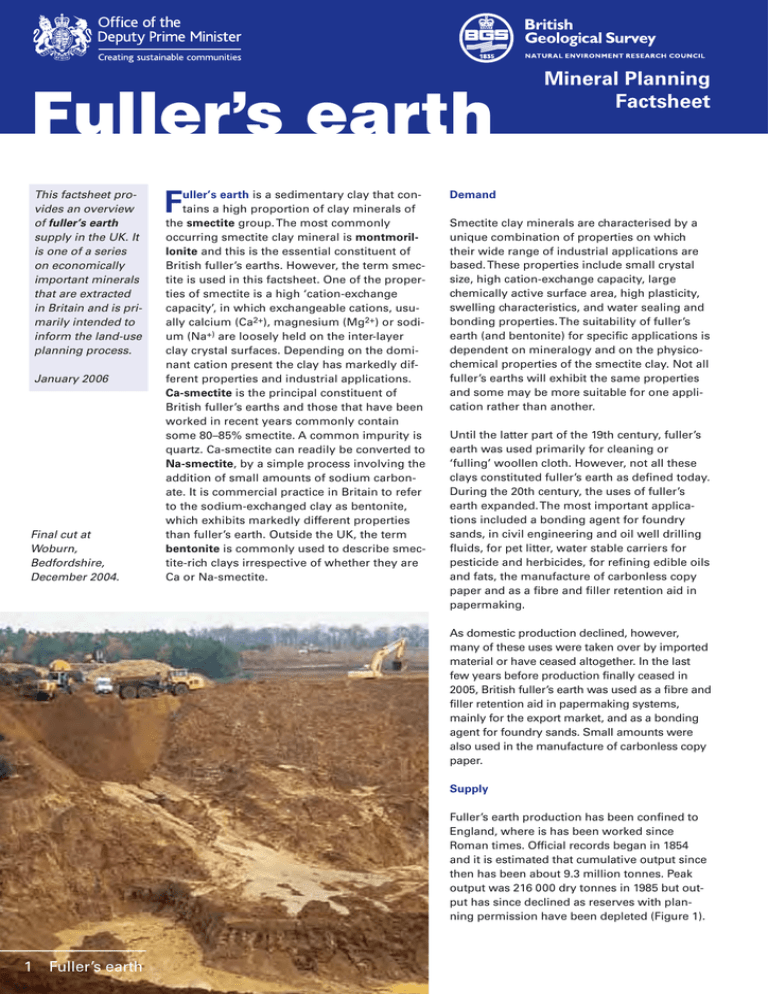
Fuller’s earth
This factsheet provides an overview
of fuller’s earth
supply in the UK. It
is one of a series
on economically
important minerals
that are extracted
in Britain and is primarily intended to
inform the land-use
planning process.
January 2006
Final cut at
Woburn,
Bedfordshire,
December 2004.
uller’s earth is a sedimentary clay that contains a high proportion of clay minerals of
the smectite group. The most commonly
occurring smectite clay mineral is montmorillonite and this is the essential constituent of
British fuller’s earths. However, the term smectite is used in this factsheet. One of the properties of smectite is a high ‘cation-exchange
capacity’, in which exchangeable cations, usually calcium (Ca2+), magnesium (Mg2+) or sodium (Na+) are loosely held on the inter-layer
clay crystal surfaces. Depending on the dominant cation present the clay has markedly different properties and industrial applications.
Ca-smectite is the principal constituent of
British fuller’s earths and those that have been
worked in recent years commonly contain
some 80–85% smectite. A common impurity is
quartz. Ca-smectite can readily be converted to
Na-smectite, by a simple process involving the
addition of small amounts of sodium carbonate. It is commercial practice in Britain to refer
to the sodium-exchanged clay as bentonite,
which exhibits markedly different properties
than fuller’s earth. Outside the UK, the term
bentonite is commonly used to describe smectite-rich clays irrespective of whether they are
Ca or Na-smectite.
F
Mineral Planning
Factsheet
Demand
Smectite clay minerals are characterised by a
unique combination of properties on which
their wide range of industrial applications are
based. These properties include small crystal
size, high cation-exchange capacity, large
chemically active surface area, high plasticity,
swelling characteristics, and water sealing and
bonding properties. The suitability of fuller’s
earth (and bentonite) for specific applications is
dependent on mineralogy and on the physicochemical properties of the smectite clay. Not all
fuller’s earths will exhibit the same properties
and some may be more suitable for one application rather than another.
Until the latter part of the 19th century, fuller’s
earth was used primarily for cleaning or
‘fulling’ woollen cloth. However, not all these
clays constituted fuller’s earth as defined today.
During the 20th century, the uses of fuller’s
earth expanded. The most important applications included a bonding agent for foundry
sands, in civil engineering and oil well drilling
fluids, for pet litter, water stable carriers for
pesticide and herbicides, for refining edible oils
and fats, the manufacture of carbonless copy
paper and as a fibre and filler retention aid in
papermaking.
As domestic production declined, however,
many of these uses were taken over by imported
material or have ceased altogether. In the last
few years before production finally ceased in
2005, British fuller’s earth was used as a fibre and
filler retention aid in papermaking systems,
mainly for the export market, and as a bonding
agent for foundry sands. Small amounts were
also used in the manufacture of carbonless copy
paper.
Supply
Fuller’s earth production has been confined to
England, where is has been worked since
Roman times. Official records began in 1854
and it is estimated that cumulative output since
then has been about 9.3 million tonnes. Peak
output was 216 000 dry tonnes in 1985 but output has since declined as reserves with planning permission have been depleted (Figure 1).
1
Fuller’s earth
Mineral Planning
Factsheet
Fuller’s earth
Sales were 26 000 dry tonnes in 2004 and 6 200
tonnes in 2005 when production finally ceased
bringing to an end this long established minerals industry. Recent production was confined to
Baulking in Oxfordshire and Woburn in
Bedfordshire. Production at Baulking ceased in
October 2005 and at Woburn in December 2004.
Exports
Imports
Tonnes
£000
Tonnes
£000
1999
76 459
17 784
246 341
13 021
2000
75 472
15 774
255 942
14 129
2001
72 983
16 314
235 517
14 731
250
2002
81 707
17 538
215 022
12 189
200
2003
75 099
19 179
198 434
10 102
2004
72 526
18 241
182 414
12 051
150
100
Table 1 UK: Imports and exports of bentonite,
1999–2004. Source: HM Revenue & Customs.
50
0
1980
1984
1988
1992
1996
2000
2004
Figure 1 England: Production of fuller’s earth,
1980–2005. Source: United Kingdom Minerals
Yearbook, BGS.
Consumption
UK consumption of fuller’s earth/bentonite is
currently believed to about 180 000 t/y.
Economic importance
Historically, the deposits in the Redhill-Nutfield
area of Surrey have been the most important
source, accounting for about 65% of the total
cumulative output. However, production ceased
in Surrey in 1998. The deposits between Woburn
and Woburn Sands in Bedfordshire were the second most important source and accounted for
about 1.6 million tonnes of product. Elsewhere
fuller’s earth has been worked at Clophill, also in
Bedfordshire (production ceased in late 2000)
and, on a modest scale in Kent, where production stopped in 1983. Underground mining in the
Bath area ceased in 1979.
Trade
UK trade is believed to be mainly in the form of
bentonite. With the depletion of indigenous
reserves and a consequent decline in production, imports of bentonite have generally been
on a rising trend, being 77 000 tones in 1980,
154 000 tonnes in 1990 and over 255 000
tonnes in 2000. However, since then imports
have decreased, possibly reflecting declining
use in the castings industry as foundries continue to close (Table 1).
The total value of fuller’s earth sales in 2004
was estimated at about £2.6 million, but less
than £1 million in 2005. Indigenously produced
fuller’s earth is no longer of economic importance in Britain following the cessation of production.
Structure of the industry
Fuller’s earth was until 2004 produced by two
companies in Britain; Rockwood Absorbents
(Baulking) Ltd and Steetley Bentonite and
Absorbents Ltd. Rockwood’s operation was at
Baulking in Oxfordshire. The original quarry
was exhausted in summer 2002 and has been
restored to a water feature. Until its closure in
2005 sales have been based on stockpiles of
crude fuller’s earth, both from Baulking and the
company’s former operation at Clophill.
Baulking clay was converted to bentonite on
site for use as a fibre and filler retention aid in
papermaking and a bonding agent for foundry
sand. The company used the Clophill clay internally as an additive to imported white bentonite used in the manufacture of carbonless
Fuller’s earth
Thousand Tonnes (dry)
Fuller’s earth
2
Fuller’s earth
Mineral Planning
Factsheet
effectively absent in British sedimentary rocks
that are older than Triassic age, largely
because such rocks have been buried more
deeply. This precludes the occurrence of
fuller’s earth over large tracts of western and
central Britain where the rocks are almost
exclusively of pre-Jurassic age. In addition,
although smectite is abundant in the clay
fraction (<2 microns) of many sediments of
post-Triassic age, in most of these the clay
fraction only forms a small part of the whole
rock. Overall concentrations of smectite are
small and even in mudstones (clay-rich rocks)
only very rarely exceed 30%.
Fuller’s earth deposits were formed by the
alteration of volcanic ash deposited in seawater. The accumulation and, more importantly,
preservation of volcanic ash to form fuller’s
earth beds of sufficient thickness for commercial extraction involved a complex set of geological processes. In Britain these conditions
have occurred only rarely and over geographically-restricted areas. Consequently, fuller’s
earth deposits of potential economic interest
have a very restricted distribution in Britain.
Figure 2 Distribution of fuller’s earth
resources.
copy paper. The Baulking operation was formerly owned by Laporte Absorbents but was
acquired in 2000 by Kohlberg Kravis Roberts &
Co, a US investment firm.
Steetley Bentonite and Absorbents, a whollyowned subsidiary of Tolsa SA of Spain, has produced fuller’s earth near Woburn in
Bedfordshire since the early 1950s. However,
production ceased in December 2004 due to
the exhaustion of permitted reserves.
Resources
Smectite clay minerals are stable at the
Earth’s surface and in shallow sedimentary
basins, but with increasing depth of burial
they progressively alter to other clay minerals
with no useful properties. Discrete smectite is
3
Fuller’s earth
Fuller’s earth beds range in thickness from a
few centimetres up to some 5 m, although
2–3 m is more typical of worked deposits. The
beds are often lens-shaped and some may only
persist over a few tens of metres. However,
others are more extensive and in rare cases
beds can be traced for several kilometres.
Different beds may have different properties
depending on the amount of contaminating
impurities present and the inherent characteristics of the smectite clay mineral. This may be
due to small differences in the way that the clay
originally formed from volcanic ash.
Fuller’s earth deposits that are, or have been, of
commercial interest in Britain occur only in
sediments of Middle Jurassic (Bathonian) and
Lower Cretaceous (Aptian) age in southern
England (Figure 2). Jurassic resources are confined to a single bed (the Fuller’s Earth Bed)
which is up to 3.3 m thick and occurs 3 m to
10 m below the top of the Fuller’s Earth
Formation at the base of the Great Oolite. The
extent of the Fuller’s Earth Bed is fairly well
defined to the south of Bath where resources
Fuller’s earth
Restored Baulking Quarry, Oxfordshire.
are several million tonnes. These resources are
considerably more extensive than the Lower
Cretaceous deposits in the Lower Greensand
but are only workable by underground methods. Mining ceased in 1979 for economic reasons and because of the low quality of the
fuller’s earth, which contains a high proportion
of calcite with smectite contents of only some
60%. Fuller’s earth production was mainly confined to deposits in the Lower Cretaceous
Lower Greensand which have accounted for
most of cumalative output.
The deposits in the Redhill-Nutfield area of
Surrey have been by far the most important,
with those between Woburn and Woburn Sands
in Bedfordshire being the second most important source. Elsewhere deposits have been
worked at Clophill, also in Bedfordshire, at
Baulking in Oxfordshire and, on a modest
scale, at Maidstone in Kent. A number of
fuller’s earth occurrences have been identified
in West Sussex and Hampshire but none are
considered to be of economic interest.
The British Geological Survey undertook a
detailed appraisal of fuller’s earth resources in
England in 1990–91. During the course of this
appraisal a number of new occurrences of
fuller’s earth were discovered. The majority of
these were thin beds, often of low grade and of
no economic interest. More significant discoveries included extensions to the already known
deposits in the Godstone-Tandridge area in
Surrey and a satellite deposit in the Baulking
area in Oxfordshire.
The examination of a large volume of data collected over many years, together with up-todate geological knowledge on the origin and
occurrence of fuller’s earth has also shown that
large parts of the Lower Greensand are not
prospective for fuller’s earth. Moreover, no
fuller’s earth deposits comparable to those in
the Bath area appear to exist elsewhere within
Jurassic strata in England.
The conclusions of the BGS study were that the
best prospects for finding thick fuller’s earth
Fuller’s earth
Mineral Planning
Factsheet
Fuller’s earth
4
Fuller’s earth
Fuller’s earth
5
Fuller’s earth
Mineral Planning
Factsheet
deposits were in those areas near to known
deposits. In addition, the BGS stated that in
view of the large body of data now available it
is extremely unlikely that deposits of a size
comparable to the Redhill and Woburn deposits
remain undetected. Since the publication of the
1991 report the BGS is not aware of any new
discoveries of fuller’s earth and believe that the
conclusions to their report remain valid.
The Woburn deposit occurs in a locally-designated Area of Great Landscape Value. This was
a major factor in the refusal of the planning
application to work the final southern extension
of the deposit. The need for the mineral was
held to be insufficient to outweigh the environmental drawbacks given the alternative solutions likely to be available to the papermaking
industry.
Reserves
Extraction and processing
Reserves of fuller's earth with planning permission are confined to a small satellite deposit at
Moor Mill Farm, about 2 km from the plant at
Baulking in Oxfordshire. The deposit, which contains the equivalent of about 300 000 dry tonnes
of product, was granted planning permission in
1998 and was to have been opened up in 2004.
However, a significant deterioration in the market
for UK fuller’s earth has rendered such a small
deposit uneconomic and no working will now
take place. The decline in the market has been
due to the continuing contraction of the foundry
industry and the loss of the papermaking market.
Since 1979, when underground mining of the
Jurassic fuller’s earth near Bath ceased for economic reasons, extraction has been solely by
opencast methods. Overburden to mineral
thickness ratios depend on the nature of the
overburden and the ease, and thus cost of
removal; ratios of 20 to 1 have been feasible in
soft sand.
At Woburn, a planning application to work the
southern and final extension of the fuller’s earth
deposit was refused planning permission in July
2002 following a public inquiry. The site
(Wavendon Heath South) contains 320 000 dry
tonnes of fuller’s earth.
In Surrey, an application to extract a reported
one million dry tonnes of fuller’s earth at the
Waterhouse Farm site, near Bletchingley and
0.59 million dry tonnes at the Jackass Lane site,
near Tandridge was refused in 1989 following a
public inquiry.
Fuller’s earth is never used in raw form but
undergoes processing essentially to modify its
properties for a particular use rather than to
increase the smectite content of the clay. In the
past this processing involved acid activation or
leaching with sulphuric acid.
Fuller’s earth is characterised by a high moisture content of up to 40%. Initial processing
consisted of crushing and drying prior to being
milled to a fine powder. The air swept grinding
mills used meant that there was some removal
of coarse sand particles. Almost all fuller’s
earth extracted recently in Britain was converted to bentonite. This involved the introduction
of small amounts of sodium carbonate (usually
2 to 4%) to the wet clay prior to drying and
grinding which converted the Ca-smectite to
Na-smectite by cation exchange.
Relationship to environmental designations
By-products
Extensive parts of the Lower Greensand of the
Weald, particularly in west Surrey, parts of
Hampshire and West Sussex, occur within
AONBs. Much of the remainder of the Lower
Greensand outcrop lies adjacent to these areas.
The Surrey deposits are adjacent to the Surrey
Hills AONB. The Bath deposits partly lie within
the Cotswolds AONB.
There were no by-products of fuller’s earth
extraction. In the past calcareous sandstones
associated with the fuller’s earth beds in Surrey
were used as a local source of low-grade
crushed fill. Elsewhere the Woburn Sands overlying the fuller’s earth bed at Woburn are too
fine-grained for commercial use.
Mineral Planning
Factsheet
Fuller’s earth
The large void created by the extraction of
fuller’s earth at Redhill has been used for landfill.
costs of underground mining, and not planning
related. However, any future scope for surface
working would be limited by both economics
and planning.
Alternatives/recycling
In the foundry industry most metal is cast in
‘greensand’ moulds in which a mixture of silica
sand and bentonite is mixed with water to give
sufficient plasticity for the mould to be formed.
Volume producers of castings use automatic
systems in which the used mould is disaggregated and the sand recycled with a small addition of new bentonite to replace that destroyed
in the casting process.
Transport issues
Fuller’s earth products were transported by
road in bulk or in bags.
Planning issues
The geology of fuller’s earth in England means
that workable deposits are very restricted in
their geographical and geological extent. A significant proportion of known deposits are now
exhausted. Those that remain are either small
and uneconomic or in areas where the need for
the mineral was held to be insufficient to override the harm to local amenities (principally
landscape), despite the fact that none of these
are in areas designated as nationally significant
(although the Surrey sites are overlooked by an
AONB). Planning decisions in Surrey and
Bedfordshire have been critical in forcing the
closure of the industry, in what were its main
producing areas. At Baulking in Oxfordshire a
rapidly deteriorating market has resulted in
previously permitted reserves becoming
uneconomic to work.
The closure of the Bath deposits was a result of
geology and economics, relating to the high
Further information
An appraisal of fuller’s earth resources in
England and Wales. B S P MOORLOCK and D E
HIGHLEY. British Geological Survey Technical
Report. WA/91/75. 87pp.
Authorship and acknowledgements
This factsheet was produced by the British
Geological Survey for the Office of the Deputy
Prime Minster to support the research project
‘Review of Planning Issues Relevant to Some
Non-Energy Minerals other than Aggregates, in
England’ (2004). It was updated under the
research project ‘ODPM-BGS Joint Minerals
Programme’.
It was compiled by David Highley, Andrew
Bloodworth (British Geological Survey) and
Richard Bate (Green Balance Planning and
Environmental Services), with the assistance of
Don Cameron and Deborah Rayner.
The invaluable advice and assistance of the
minerals industry in the preparation of this factsheet is gratefully acknowledged.
Mineral Planning Factsheets for a range of
other minerals produced in England are available for download from www.mineralsUK.com
© Crown Copyright 2006.
Unless otherwise stated all illustrations and
photos used in this factsheet are BGS©NERC.
All rights reserved.
Fuller’s earth
Other fibre and filler retention systems are
used in the paper industry, although none have
a manufacturing base in the UK.
Although the use of domestically-produced
fuller’s earth as pet litter has been an issue in
the past, all recent production from England
has been for higher value applications
described earlier in this factsheet.
Fuller’s earth
6



